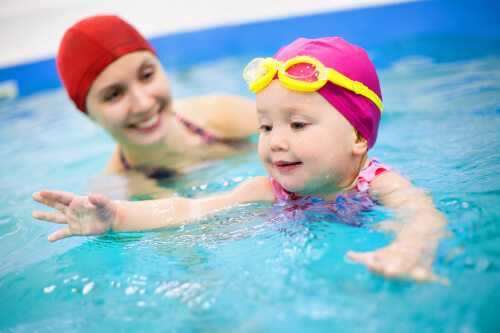Teaching your child to swim can be really difficult. Children, especially young ones, are known to be impatient and annoying when it comes to learning how to swim. If you have a temperamental child and you want them to learn how to swim this summer, check out a few helpful tips on how to teach your child to swim.
1. Safety first
You wouldn’t believe how many parents don’t think about dangerous things that can potentially happen when teaching a child to swim. It’s important that you make sure you have enough space in the ocean or pool to swim, make sure your child always stays hydrated and, of course, healthy. Remember to be aware of dangers of cracked skulls, broken bones and drowning. Also be sure to know standard CPR or have someone who can help.
2. Think of pool toys
Many people think that pool toys like life savers or noodle floats can be distracting, but if you’re having a difficult time with teaching your child to swim, all those pool toys might be very helpful. If you don’t want your child to get turned off from swimming, add some pool toys so your kid can associate swimming with staying active and having fun in the summer.
3. Think of floaties
Okay, not every child likes the idea of wearing floaties, but if your child is excited to wear floaties, consider yourself lucky. Floats are extremely important, especially when you first start teaching your little one to swim, since that’s usually when your kid may need them the most. Remember, it’s always better to be safe than sorry!
Read also – 7 Useful Habits You Should Teach Your Children
4. Don’t work alone
If you’re a single parent, ask someone else to help you, for instance, close family members or neighboring mothers. Even if you’re used to taking care of your little one by yourself, it’s always good to have another swimmer to assist you. Moreover, your child may learn much faster with 2 different teaching styles than only one.
5. Teach your child to breathe underwater
Another step to go through when teaching your little one to swim is to make sure that your child knows how to breathe underwater. One of the best ways to go about it is through the counting method. Watch your kid blow bubbles underwater and count to 5 as he/she holds on to you. It is very important to master this technique. You don’t want to see your child suffocate herself/himself while swimming because they couldn’t find out how to breathe underwater correctly.
6. Teach your child to float
Children often have a difficult time learning to float. Although it requires a lot of patience and reassurance, it’s actually worth the effort since floating is such a vital safety skill. At first, your little one might struggle and this tension can cause them to fold in at the waist. Explain to your child that they should relax if they want to learn to float. Try to encourage your child to lie back in the bath or in the pool first. This will take a few attempts and lots of reassurance, but both you and your kid will be satisfied with the results.
7. Teach your child to kick their feet
Help your kid learn to kick their feet. Have them scissor kick their legs and ask them to make as many bubbles as they can. You can even make a fun game out of it and see how much froth your child can make. Help your child to fully enjoy their lesson. Once they have acquired the basic skills, you can start to teach beginning arm strokes as well as more advanced swimming techniques.
Read also – 7 Important Reasons to Involve Your Children in Daily Routines
8. Look for professional help
If teaching your kid to swim on your own seems impossible, don’t give up! Opt for some professional swimming lessons at the community center. A lot of young people, who were successful swimmers in high school or college, offer swimming lessons at a reasonable price. If you can teach your child, these lessons may not be necessary, but if you have a busy schedule and you want your little one to learn how to swim, enroll them in some good swimming lessons.
9. Be patient
One of the best ways to teach your little one anything new is to display as much patience as possible, and don’t overreact when you kid looks to you for help. Everybody has different learning styles and speeds, keep it in mind and try to be patient when teaching your little one how to swim.
Have you had a difficult time teaching your little one to swim? What tips can you suggest to other moms looking to teach their children to swim? Share your tips with us please.

